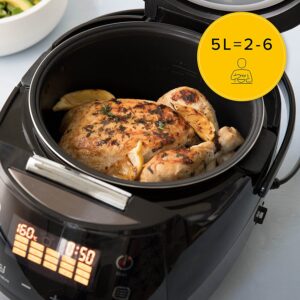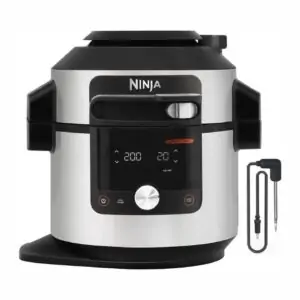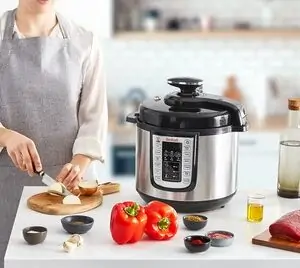Few things come close to being as delicious as the perfectly cooked gammon joint.
A Gammon roast is always a winner, particularly at Christmas, but there’s no reason that you can’t have it on more occasions than just Christmas, right?
Cooking your gammon joint in a Ninja Foodi produces a healthier result than traditional cooking methods and in much less time to boot! Let’s get cooking …
JUMP TO:
How To Make Gammon A Healthier Cut Of Meat
It’s true that a Ninja Foodi reduces your cooking time and gives you a healthier cut of meat.
Just as an aside, this appliance handles a range of functions such as sauteing, pressure cooking, slow cooking, grilling, and air frying, giving you more space on your countertop and less washing up to do after the meal.
Either way you look at it, owning a Ninja Foodi is a win-win all around!
For times when you want a quick, nearly effortless joint of roast gammon for dinner (a lifesaver, especially when you have unexpected guests!), the Ninja Foodi will come to your rescue. Here’s my guide to cooking gammon perfectly with the Ninja Foodi.
But First, What Is Gammon?
If you’re new to gammon, here’s a brief introduction to the cut.
Gammon is cured pork, cured either by brining or dry-salting. It is a cut from the animal’s hind leg and may also be smoked.
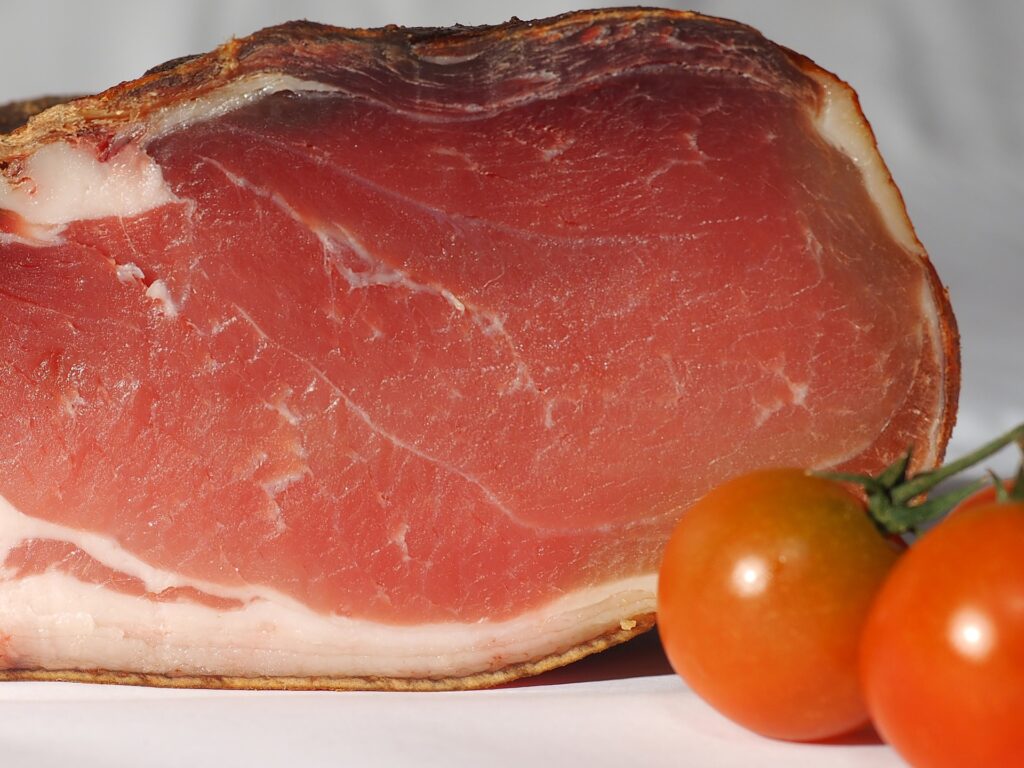
Gammon cannot be eaten raw like other dry-cured meats like ham; it has to be cooked well to be both tasty and safe.
How Long Should You Cook Gammon For?
There are many differing opinions on how long gammon should be cooked. How long you cook your gammon depends on the size of the joint as well as the texture you hope to achieve, ranging from sliceable to shreddable.
If you’re cooking 500 grams of gammon, cook it for around twelve minutes for an easy-to-slice texture and 14 minutes for a more crumbly, soft texture.
The cooking time will increase proportionately to the quantity of meat (24 minutes for a kilogram of sliceable gammon, 28 minutes for a kilogram of shreddable meat, and so on).
It should be noted that the Foodi’s built-in timer will only start counting down once sufficient pressure has built up inside.
The amount of water inside and the size of the gammon will determine how long it takes for the pressure to build up.
Around two kilograms typically take around 12-14 minutes to reach the desired pressure (using hot water instead of plain water, as mentioned earlier).
The timer will beep once the cooking is done, with a second timer starting to count the natural release time.
How Long To Cook An Uncooked 750g Gammon Joint In Ninja Foodi
Since 500 grams of gammon take around 12 minutes, 750 grams should take around 18 minutes to cook completely.
Again, you can always test the meat’s internal temperature to ensure it has cooked sufficiently. It should reach 68°C using your Thermometer.
Gammon Cooking Times Guide
This depends on what result you are looking for and the way you want to use the Gammon
- Ham that is easy to slice will give you many uses.
- A crumbly or shredded texture, which is much more like pulled pork
Easy Slice
-
Size of the Joint
Cooking Time
-
500 grams
12 minutes
-
1 kg
24 minutes
-
1.5 kg
36 minutes
*For every extra 500 grams Add 10 minutes.
Shredded Style
-
Size of the Joint
Cooking Time
-
500 grams
14 minutes
-
1 kg
28 minutes
-
1.5 kg
42 minutes
*For every extra 500 grams, add 12 minutes.
Leave the pressure to release naturally.
To speed up the process, the Ninja Kitchen recommends you use hot water.
Slow-Cooking Gammon In The Ninja Foodi
You can also slow cook gammon in the Ninja Foodi. To slow-cook 750 grams of gammon, use the Foodi in the “High” setting for around four hours or in the “Low” setting for eight hours—you can even leave it overnight.
Add a little broth, water, or any liquid to the pot so the meat doesn’t stick. Additionally, ensure you turn the meat every hour and a half to get the glaze evenly coated on the meat.
Rest the meat before you serve it, or if you’re too impatient, shred it and serve it—just as delicious!

Cooking Gammon With A Ninja Foodi
The Ninja Foodi lets you pressure/slow-cook gammon perfectly. Here’s my step-by-step guide to slow-cooking gammon with the Ninja Foodi.
How To Cook Gammon In A Ninja Foodi Recipe
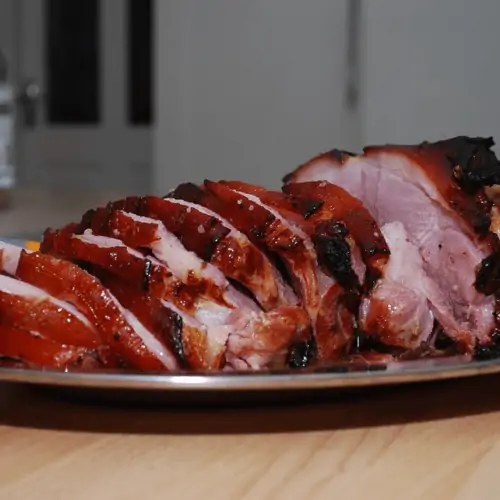
Equipment
- The Foodi trivet
Ingredients
- 1 kilo Gammon joint, can be smoked or unsmoked
- Aromatics such as onions carrots, garlic, herbs, bay leaves, celery including some of the leaves and the like
- Salt, pepper, and seasonings to taste if preferred
- Water, Sufficient to immerge the Gammon joint
Method
Cooking The Gammon
- To remove some of the saltiness, soak the gammon overnight in water; if time is a luxury you can’t afford, boil the gammon, for about 30 minutes, in a large saucepan.
- To make things even easier, you can simply boil your gammon in the Ninja Foodi bowl itself, for around 30 minutes using the ‘sear/saute’ mode, set to “High”.
- Once the meat is done boiling/soaking, drain all the salty water.
- Place the entire joint of gammon in the Ninja Foodi bowl. Roughly chop your aromatics and add them to the bowl, sprinkled all over and around the gammon.
- Next, add the water. Add as much as is necessary to mostly submerge the gammon and ensure that the water added doesn’t exceed the maximum line marking on the inside of the bowl.
- To hasten the cooking process, you can add hot water instead of plain water. Hot water will help the pressure build faster inside the Foodi.
- Once done, seal the pot with the pressure cooker lid and turn the valve to “Seal”, so that the lid is securely locked in place.
- Put the Foodi in the pressure cooker mode, at the highest pressure.
- Different cooking times will achieve different results—see the table below.
- Once the cooking time is up, let the Foodi naturally release steam before you remove the joint.
- A quick release may result in improperly cooked meat., but if you’re working with small quantities (500 g or less), the quick release of steam is necessary to prevent overcooking.
- The valve, which automatically pops up once pressure has built and the cooking starts, will drop back down on its own once all the steam is released.
- Before you serve the gammon, let it rest for 10 minutes so that it’s easier to cut through. The leftover cooking liquid can be used as a broth or stock, if you have removed the saltiness first.
Finishing In The Air Fryer
- If you’d like, you can also finish off the joint with air frying in the Foodi. Once you’ve drained the stock, wash and dry your Foodi bowl properly, put the gammon back in, and baste it with your preferred marinade or glaze.
- Some delicious options include cinnamon, apple juice, and maple syrup, honey and mustard, or brown sugar, ground ginger, and pineapple juice. See recipes below.
- Close the lid and put the Foodi in the air fryer mode. Set the temperature to 180℃/350℉ and cook for around five or ten minutes. You want the meat to crisp nicely and not burn, so keep a careful watch on the meat.
- You may want to check it after five minutes to see if it needs more cooking, or better yet, check the meat’s internal temperature with a thermometer to see if it’s cooked. 68℃/155℉ is the minimum internal temperature you’re looking for.
- Remove the meat once cooked, let it rest for ten minutes, and then carve. Enjoy
FAQ
What Are My Options For Glazing My Gammon Joint?
- Honey and Mustard
- Maple Syrup and Ginger
- Pineapple juice, brown sugar and ground ginger
- Marmalade and whiskey
- Orange and cranberry
- Fig and vanilla
What Do You Look For When Buying a Gammon Joint?
When buying a gammon joint, there are several important factors to consider.
- First, you should look at the joint’s size–make sure it is big enough to serve your needs.
- Next, you should check the fat content – gammon joints with higher fat content will be more flavorful and tender when cooked.
- You should also inspect the joint for any signs of discolouration, indicating that the meat may not be fresh.
- Finally, you should look for a joint with a uniform thickness so that it cooks evenly.
- Ask your butcher or grocery store staff to help you find the best quality gammon joint for your needs.
Smoked vs Unsmoked Gammon: Which Should I Buy?
Choosing a smoked or unsmoked gammon depends on the dish you prepare. Unsmoked (or green) gammon is essentially cured pork, but it has not been smoked and has no smoky flavour. Infusing the dish with your own seasonings and flavours is a great choice.
Smoked gammon, conversely, has been cured and then smoked over wood chips or charcoal, giving it a distinctive smoky flavour. It is usually used in dishes like stews or casseroles, where its smokiness can be appreciated without additional seasoning. Ultimately, the decision between smoked and unsmoked gammon comes down to personal taste – so why not try both and see which one you prefer?
What’s The Difference Between Gammon and Ham?
The main difference between gammon and ham is that gammon is a type of cured pork made from the hind leg of a pig, while ham is generally made from a pig’s hind leg or shoulder. The curing process for both meats involves salt, sugar, spices, and sometimes smoke. The cure used for gammon tends to be sweeter than ham’s, resulting in a slightly different flavour when cooked. Gammon is also usually sold uncooked with the bone still in it, while ham is usually pre-cooked and boneless. Additionally, gammon can be boiled or roasted before eating, while ham is typically eaten cold.
What Does Gammon Go Best With?
Gammon is a delicious cut of pork that can be enjoyed in many ways. It pairs well with various ingredients and flavours, making it a versatile dish for any occasion.
Some classic pairings for gammon include applesauce, honey mustard sauce, roasted vegetables, mashed potatoes, and crusty bread.
If you want something more adventurous, pair your gammon with spicy chutney, pickled onions, or zesty salsa.
For a light and fresh accompaniment, serve your gammon with crunchy salad greens or roasted root vegetables.
How To Make Gammon Festive For Christmas?
Gammon can be made festive for Christmas with a few simple tweaks. To give your gammon a holiday-inspired twist, try adding some festive ingredients and flavours to the mix.
Consider using a spiced or aromatic rub to coat the gammon before cooking. This can be as simple as mixing together some herbs, spices, and aromatics such as garlic, rosemary, sage, or thyme. You could add chopped fruits like apples or oranges for a sweet flavour. If you prefer a sweeter gammon, try brushing it with honey or maple syrup before baking.
To finish your festive gammon meal, serve it with seasonal sides such as roasted root vegetables, or Brussels sprouts with bacon and chestnuts. For an extra special touch, garnish the dish with fresh cranberries or pomegranate seeds for a pop of colour and flavour. With these simple tips, you can make any ordinary gammon dinner into something special for your Christmas celebration!
What To Do With Leftover Gammon Joint?
Leftover gammon joints can be used to make a variety of delicious dishes. Here are some ideas for how to use it up:
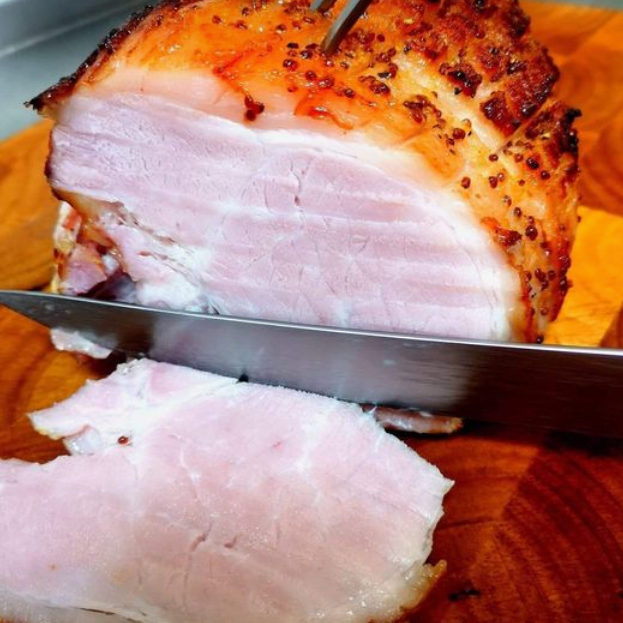
1. Add it to salads or sandwiches for extra protein and flavour.
2. Cube it and fry it with vegetables to make a tasty stir-fry dish.
3. Make a traditional English ploughman’s lunch by serving the gammon joint with crusty bread, pickles, and cheese.
4. Use the cooked gammon in quiches, omelettes, or frittatas for a hearty breakfast or brunch dish.
5. Dice the gammon and mix it into an egg-based casserole, or bake it with your favourite cheese sauce for a comforting dinner dish.
6. Make a classic British sandwich by combining the gammon with pickle and mustard on white bread for a tasty snack or light meal.
7. Shred the cooked meat in tacos, burritos, wraps, or other Mexican-inspired dishes for a flavour twist!
How To Cook Gammon In A Ninja Foodi: Wrapping Up
With a Ninja Foodi in the kitchen, making even a usually complex and time-consuming dish like roast gammon becomes a breeze! While starting off the first time may seem overwhelming, you’ll see how easy it gets as you get on with the process, and with just a few attempts, you’ll be cooking gammon like a pro.
Just ensure that you follow the instructions I’ve listed above and the instructions in the Foodi manual, along with the manufacturer’s recommendations, for the best results. This doesn’t just extend to cooking gammon but to all other Ninja Foodi dishes.
Here are some more great Ninja Foodi recipes you can enjoy today!
Ninja Foodi Roast Beef
Ninja Foodi Ham
Ninja Foodi Chips
Ninja Foodi Yorkshire Pudding


